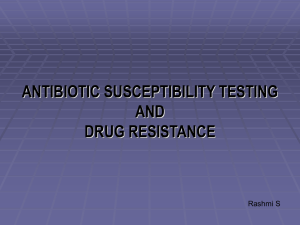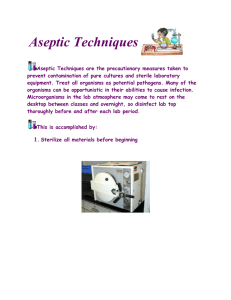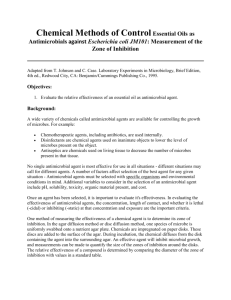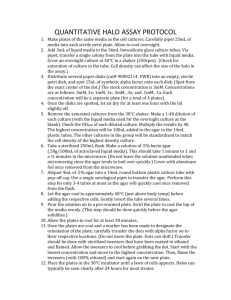E-1 Bactericide - CalAgEd Data Portal
advertisement
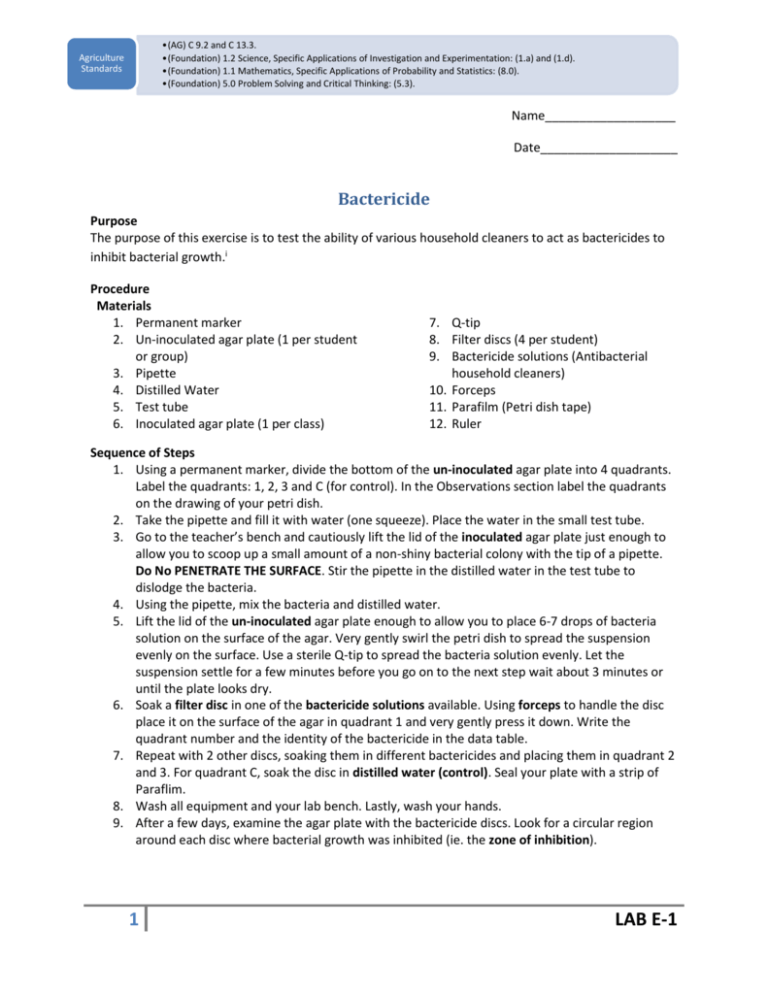
•(AG) C 9.2 and C 13.3. •(Foundation) 1.2 Science, Specific Applications of Investigation and Experimentation: (1.a) and (1.d). •(Foundation) 1.1 Mathematics, Specific Applications of Probability and Statistics: (8.0). •(Foundation) 5.0 Problem Solving and Critical Thinking: (5.3). Agriculture Standards Name___________________ Date____________________ Bactericide Purpose The purpose of this exercise is to test the ability of various household cleaners to act as bactericides to inhibit bacterial growth.i Procedure Materials 1. Permanent marker 2. Un-inoculated agar plate (1 per student or group) 3. Pipette 4. Distilled Water 5. Test tube 6. Inoculated agar plate (1 per class) 7. Q-tip 8. Filter discs (4 per student) 9. Bactericide solutions (Antibacterial household cleaners) 10. Forceps 11. Parafilm (Petri dish tape) 12. Ruler Sequence of Steps 1. Using a permanent marker, divide the bottom of the un-inoculated agar plate into 4 quadrants. Label the quadrants: 1, 2, 3 and C (for control). In the Observations section label the quadrants on the drawing of your petri dish. 2. Take the pipette and fill it with water (one squeeze). Place the water in the small test tube. 3. Go to the teacher’s bench and cautiously lift the lid of the inoculated agar plate just enough to allow you to scoop up a small amount of a non-shiny bacterial colony with the tip of a pipette. Do No PENETRATE THE SURFACE. Stir the pipette in the distilled water in the test tube to dislodge the bacteria. 4. Using the pipette, mix the bacteria and distilled water. 5. Lift the lid of the un-inoculated agar plate enough to allow you to place 6-7 drops of bacteria solution on the surface of the agar. Very gently swirl the petri dish to spread the suspension evenly on the surface. Use a sterile Q-tip to spread the bacteria solution evenly. Let the suspension settle for a few minutes before you go on to the next step wait about 3 minutes or until the plate looks dry. 6. Soak a filter disc in one of the bactericide solutions available. Using forceps to handle the disc place it on the surface of the agar in quadrant 1 and very gently press it down. Write the quadrant number and the identity of the bactericide in the data table. 7. Repeat with 2 other discs, soaking them in different bactericides and placing them in quadrant 2 and 3. For quadrant C, soak the disc in distilled water (control). Seal your plate with a strip of Paraflim. 8. Wash all equipment and your lab bench. Lastly, wash your hands. 9. After a few days, examine the agar plate with the bactericide discs. Look for a circular region around each disc where bacterial growth was inhibited (ie. the zone of inhibition). 1 LAB E-1 10. Using a ruler, measure the zone of inhibition for each disc in millimeters mm. Measure from the center of the disc to the periphery of the inhibition (ie. to where bacterial growth begins again). Record your measurements in a table. 11. In “observations”, make a labeled drawing of your petri dish showing: quadrants, filter discs (including the names of all bactericides and control), bacterial colonies, and zones of inhibition. Observations Data Table: Effectiveness of Bactericide Disk 1. control 2. 3. 4. Diameter of zone of inhibition (mm) Labeled drawing of petri dish showing: quadrants, filter discs (including the names of all bactericides and control), bacterial colonies, and zones of inhibition. Questions: Answer questions using complete sentences except for # 2 and # 8 2 LAB E-1 1. Why was water included in the experiment as the control? 2. Order the bactericides from strongest to weakest based on their zone of inhibition. 3. If there was a zone of inhibition around the water control disc, what might you conclude? 4. What is the difference between bactericides (antiseptics) and antibiotics? 5. Bactericides are routinely used to clean wounds. Were all the bactericides in your experiment appropriate to use directly on humans? Why or why not? 6. Some people think that over use of bactericides may be harmful. Why? (Hint: think about genetics and evolution) 3 LAB E-1 7. Graph your data below. Be sure to include proper labels of the X-axis and Y-axis and labels. Give the graph a title. 8. In the experiment what is the independent variable? What is the dependent variable? i Zallo, Izaskun (2008).Bacteria Lab: Effect of Bactericides. Pleasant Grove High School Agriculture Department. 4 LAB E-1
